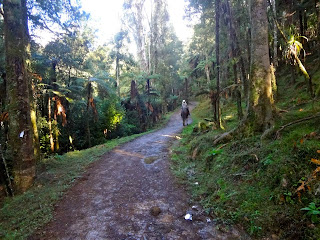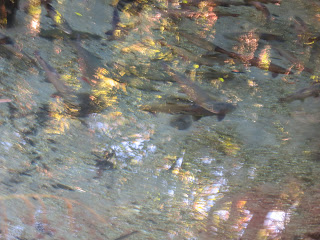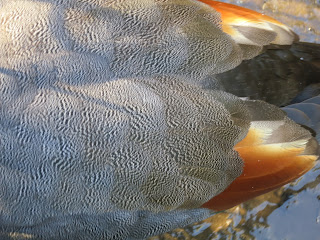Oooooookay, so I thought I would dedicate a blog post about one of the things I learned here that actually pertains to both my major and New Zealand. One of the last things I got to do is look at some kiwis which was absolutely amazing. As many of you know, or may not know, New Zealand is home to some of the most incredible endemic specimens on this lovely planet Earth and the story of how they got here and
evolved into what they are today is a very interesting theory. Before I go on I want to comment on the usage of evolution in this post. Evolution is simply just a theory NOT fact. For some reason many people seem to overlook the fallacies and flaws of evolution and accept it as something that is concrete. This is far from the truth. I have done a little research recently (by no means am I an expert at this stuff) and there is plenty of holes and lots of work yet to be done on the
theory of evolution.
Anyways, I learned about the biogeography and the native ecosystem here in New Zealand in my Ecology paper (class). I must say I am very blessed to have gotten to take my Ecology paper here as I learned sooo much about different ecosystems and I got a unique exposure to a fascinating habitat found here in NZed. My professors were fantastic (both in comparative physiology and ecology) they were down to earth, knew lots and lots about what they taught (as they are current researchers themselves, in fact in my lake ecology lab report many of my resources came from my professors work), and were enthusiastic about helping us learn their material.
So, New Zealand is a very unique environment as it was thought to have once been joined with Australia and Antarctica which was part of a super continent known as Gondwana (or Gondwanaland).
 |
| A depiction of Gondwana |
I'm going to make this as short and simple as I possibly can, the story of New Zealand's biogeography (as with many other biological things) is very complex and books and books and books can and have been written on it. Back to the story. The theory of plate tectonics explains that New Zealand then separated from this supercontinent (as did the rest of the continents) and became its own land mass (the biggest of all the polynesian islands) but as it moved it brought with it the species that were residing on Gondwana. These species are known as Gondwana relicts as the only way they would have made it to New Zealand is by basically staying on board and moving with the continent (they basically hitched a ride). There are two theories of how species can get to and inhabit different continents. By dispersal (as birds would fly) and by vicariance. Vicariance is when there is a population of a species and a barrier forms (such as mountains or in New Zealand's case the Tasman Sea) which splits the population and stops genetic exchange between individuals of the two new populations. If the populations are separated long enough it is thought they will make adaptations and there genetic material will change enough to become new species and if the two populations came into contact again they would not be able to reproduce properly, this is how ancestors are created. Now this is just a theory as there has never been a scientist in the history of the world that has been around long enough to record and witness this happening.
So species such as the tuatara, the gecko species, invertebrates (such as the weta), and frogs are thought to have hitchhiked a ride on New Zealand and were separated from their ancestors via vicariance. FYI no species or fossils of the Order Sphenodontia (tuatara) have been found where you think they would be found- in Australia or Antarctica- but they have been found in places like Europe, Africa, Madagascar, India, China and both North and South America (Gibbs, 2006). This just goes to show a hole in the theory of evolution and vicariance. Its thought that eventually we may find fossils of tuatara ancestors in Australia or Antarctica but nothing has been found yet.
 |
| This would be a weta. Imagine finding this little guy crawling across you in the middle of the night. |
 |
Tuatara, apart of Order Sphenodontia, which were thought to have been around since the time of the dinosaurs. Literally a living fossil. Thought to be separated from Gondwana by vicariance. Species on other continents went extinct by predation of mammals but since they did not have this pressure on New Zealand they were able to survive. "Today the reptilian world is divided into crocodiles, turtles, lizards and snakes, and the tuatara (Gibbs, 2006)." And I do believe that these are a reptile that are more adapted to colder climates as they are residents of the South Island.
|
Many other species joined New Zealand via dispersal such as its many endemic bird species. The type of bird that New Zealand is most known for is its ratites (flightless birds) such as the world renowned kiwi bird. It was once thought that these birds were Gondwana relicts but recent molecular evidence has shown that may not be the case. It is now being more accepted that New Zealand separated from Gondwana and then through dispersal the ancestors of the kiwi, the moa and the kakapo (and other flightless birds) arrived later. When they arrived they still had the ability to fly but that was soon unnecessary as there was no need to fly. There were no predators that required flight and all their food could be found on the rainforest floor. In the absence of mammalian predators the ratites lost wings and adapted to living on the ground (flight is a very costly metabolic function). The reason its thought there were no mammals to prey on these birds is first off islands cannot support as much biodiversity as a mainland land mass can. Secondly around 30 mya its thought that something the Oligicene drowning occurred when oceans rose and turned New Zealand into a series of islands. This drowning would have killed off many species and allowed smaller birds and reptiles to take hold of the land. During this time either moa's had already colonized the land and they were so small that they were able to survive and then there size increased after (increase in size is much more metabolically efficient). Or the moas ancestors arrived after the drowning and evolved quite fast. The closest relative to the moa is the tinamous which still has the ability to fly. I'm still doing more research on the biogeography of the kiwi but we discussed the moa in more depth in my Ecology paper.
 |
| Baby kiwi |
 |
| Kakapo, New Zeland's famous flightless parrot. |
 |
| Kiwi |
 |
| Moa interpretation |
 |
| Feather became more fur like |
 |
| Kakapo |
Just because there were no mammals does not mean there were no predators in fact one of the fiercest birds of prey evolved in New Zealand. The Haast Eagle is the biggest eagle to ever grace this planet and it would prey on moas. The laughing owl was another bird of prey on the island. Harrier hawks still inhabit the planet and I see them while traveling quite often. So this land of the birds produced some odd specimens. The birds evolved defenses against predators that would attack from the air (like birds) so they developed amazing camouflage and became nocturnal. Kiwis are very active at night and you can hear them calling in the forest at the dead of the night. But when humans came they brought with them mammals. Rats, stoats, cats, dogs, ferrets and possums devastated these birds that were adapted to only avoid birds of prey. It was very easy for these mammals to sniff out there prey and have a good feed.
Another interesting fact is when the polynesians first arrived the Haast eagle would prey on them since they were already adapted for hunting bipedal prey. Pressure from humans is what is thought to have drove the moa and the Haast eagle into extinction. It also is the reason for many many more extinctions in New Zealand. I could write for ages and ages on this topic but I am going to wrap up this session. I am currently doing more research on this stuff so I may come back and add. But this is one of my last nights here and I do not want to spend the rest of my time writing.
 |
| Harrier hawk |
 |
| Haast Eagle going at moa |











































































